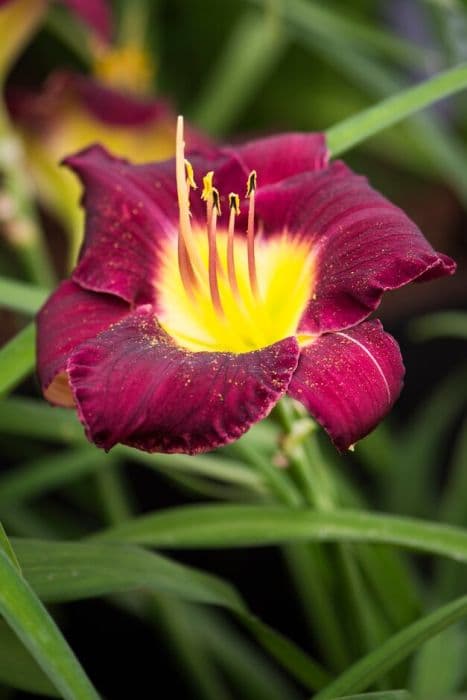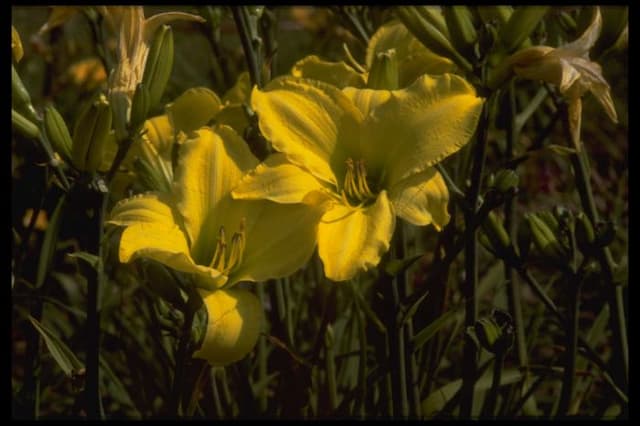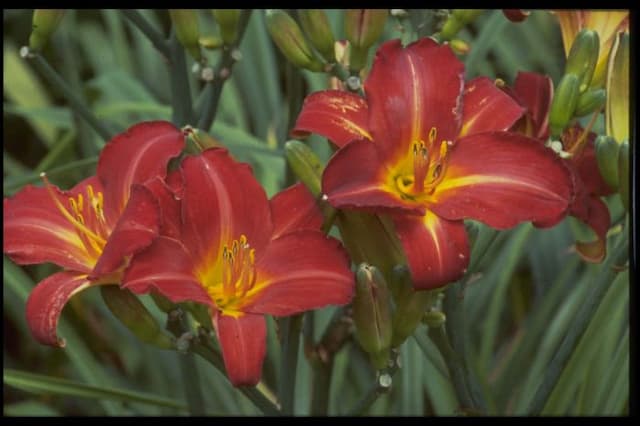Daylily Hemerocallis 'Cartwheels'

ABOUT
Hemerocallis 'Cartwheels', commonly known as the daylily 'Cartwheels', is a captivating perennial plant favored for its distinctive flowers. The blooms of this variety are particularly striking, featuring large, rounded, funnel-shaped flowers that exude an alluring charm. Each blossom showcases a sumptuous blend of colors, typically with a base color that can range from a creamy yellow to a soft peach, accented by a striking contrast of a deeper throat, which may exhibit shades of orange, red, or burgundy. The petals are often ruffled or may exhibit delicate pie-crust edges, adding a touch of elegance and a sense of movement to the flower as if it's twirling like cartwheels. Foliage is also an important aspect of the daylily 'Cartwheels', with long, linear leaves that grow in a clumping form. The leaves are a vibrant green, offering a lush backdrop that makes the colorful blooms stand out even more. The plant produces numerous flower scapes, each topped with multiple buds that open successively over a blooming period that can span several weeks. Overall, the daylily 'Cartwheels' is a lively and robust plant that is celebrated for its delightful and showy flowers that bring a dynamic visual impact to gardens and landscapes. It's a versatile plant that often finds its place in flower beds, borders, and as an accent plant, where its charming blooms can be admired up close.
About this plant
 Names
NamesFamily
Hemerocallidaceae
Synonyms
Daylily
Common names
Hemerocallis 'Cartwheels'.
 Toxicity
ToxicityTo humans
Daylilies (Hemerocallis 'Cartwheels') are generally not considered toxic to humans, and in fact, some parts of the plant, such as the flowers, are edible when properly prepared. However, as with any plant, individual allergic reactions can occur. If these happen, symptoms may include mild gastrointestinal upset or contact dermatitis. It is always prudent to avoid eating any plant part unless you are certain it is safe for you and has been correctly identified.
To pets
Daylilies are considered highly toxic to cats and can lead to serious health consequences if ingested. The ingestion of any part of the plant can cause kidney failure in cats, with symptoms that include vomiting, lethargy, loss of appetite, and increased or decreased urination. If a cat is known or suspected to have ingested daylilies, prompt veterinary attention is crucial. For dogs, daylilies are usually not toxic, but consuming large amounts may potentially cause gastrointestinal upset.
 Characteristics
CharacteristicsLife cycle
Perennials
Foliage type
Deciduous
Color of leaves
Green
Flower color
Varies
Height
2 feet (0.61 meters)
Spread
2 feet (0.61 meters)
Plant type
Herb
Hardiness zones
3-9
Native area
Asia
Benefits
 General Benefits
General Benefits- Easy to Grow: Hemerocallis 'Cartwheels', commonly known as daylily, is known for its ability to thrive with minimal care, making it suitable for gardeners of all skill levels.
- Drought Tolerant: Once established, daylilies have a high tolerance to periods of low water availability, making them ideal for drought-prone areas.
- Pest Resistant: They are less prone to pests and diseases compared to many other garden plants, which minimizes the need for chemical treatments.
- Adaptable to Various Soils: The daylily is versatile and can grow in a wide range of soil conditions, though it prefers well-drained soil.
- Long Blooming Period: Daylilies have a lengthy flowering season, with each bloom lasting only a day, but new flowers continuously emerging.
- Attracts Pollinators: The colorful blooms of the daylily attract pollinators like bees and butterflies, contributing to the health of the local ecosystem.
- Low Maintenance: These plants require minimal upkeep beyond basic watering and occasional fertilizing, making them a time-saving choice for busy gardeners.
- Varied Colors and Forms: Daylilies come in a wide range of colors and shapes, adding visual interest and aesthetic variety to gardens and landscapes.
- Excellent for Borders: Their arching leaves and clumping form make daylilies great for defining borders in garden design.
- Propagates Easily: Daylilies can be easily propagated by division, allowing gardeners to expand their gardens or share with others.
 Medical Properties
Medical PropertiesThis plant is not used for medical purposes.
 Air-purifying Qualities
Air-purifying QualitiesThis plant is not specifically known for air purifying qualities.
 Other Uses
Other Uses- Edible Decorations: The vibrant blooms of the daylily can be used to adorn cakes and desserts, providing an edible and decorative flair.
- Natural Dye: The flowers of the daylily, particularly the darker hues, can be boiled to extract dye for fabrics or handicrafts.
- Companion Planting: Daylilies can be planted in vegetable gardens to attract pollinators and beneficial insects, supporting the growth of surrounding plants.
- Fish Pond Embellishment: The sturdy leaves and attractive flowers of daylilies make them suitable for planting around fish ponds, adding beauty to aquatic landscapes.
- Erosion Control: The fibrous root system of the daylily makes it effective at holding soil in place, preventing erosion on slopes and embankments.
- Living Mulch: Daylilies can be used as groundcover to help retain moisture in the soil, suppress weeds, and reduce garden maintenance.
- Craft Material: Dried daylily stems and flowers can be used in floral arrangements, wreaths, and other craft projects.
- Gardening Education: Due to their hardiness and minimal care requirements, daylilies serve as an excellent plant for teaching gardening basics to beginners.
- Photography Subject: With their striking appearance, daylilies are a popular choice for garden photographers and can be used in photo shoots to add a pop of color.
- Culinary Experiments: The mild flavor of daylily petals can be incorporated into experimental dishes, like floral-infused ice creams or unique salads.
Interesting Facts
 Feng Shui
Feng ShuiThe Daylily is not used in Feng Shui practice.
 Zodiac Sign Compitability
Zodiac Sign CompitabilityThe Daylily is not used in astrology practice.
 Plant Symbolism
Plant Symbolism- Beauty and Elegance: Hemerocallis, commonly known as the Daylily, symbolizes beauty and elegance due to its vibrant and attractive blooms that enhance the aesthetics of gardens and natural environments.
- Motherhood and Fertility: The Daylily is often associated with motherhood and fertility, reflecting its prolific blooming nature and ability to produce multiple flowers.
- Resilience and Adaptability: Each bloom of the Daylily lasts for just one day, representing resilience and the ability to adapt to transient situations, as the plant continues to produce new flowers daily.
- Embracing Change: As a plant that presents a new flower every day, the Daylily is seen as a symbol of embracing change and the transient nature of life.
- Forgotten Memories: In the language of flowers, the Daylily can sometimes represent forgotten or fleeting memories, paralleling its short-lived blossoms.
 Water
WaterDaylilies should be watered deeply once a week during dry periods, ensuring that the water penetrates to a depth of at least 8 inches. It is important to avoid shallow watering, which can lead to weak root systems. The amount of water required may vary, but typically about 1 gallon per plant per week should suffice if there is no significant rainfall. In periods of extreme heat or if planted in sandy soils, increase the frequency to twice a week. Adjust watering based on rainfall, reducing it when there's been adequate precipitation.
 Light
LightDaylilies flourish in full sun to partial shade, requiring at least 6 hours of direct sunlight a day. The ideal spot for a Hemerocallis 'Cartwheels' is an area that receives morning sun and some afternoon shade, especially in hotter climates. Avoid deep shade, as it can reduce blooming and weaken the plant.
 Temperature
TemperatureDaylilies are hardy and versatile, with ideal growth temperatures ranging from 60°F to 75°F. These plants can survive minimum temperatures down to about -30°F, though they may become dormant during the winter. The maximum temperature for a Hemerocallis 'Cartwheels' can reach up to 90°F, beyond which the plant may need extra care to prevent stress.
 Pruning
PruningPruning daylilies involves removing spent blooms, seed pods, and yellowing leaves to promote new growth and reblooming. Prune consistently throughout the blooming season for aesthetic purposes and to direct the plant's energy back into producing flowers. The best time for major pruning is early spring or after the plant has finished blooming in the fall.
 Cleaning
CleaningAs needed
 Soil
SoilDaylilies (Hemerocallis 'Cartwheels') thrive in moderately fertile, well-draining soil with a pH range of 6.0 to 7.0. A mixture of two parts loam, one part peat moss, and one part perlite or sand creates an ideal growing medium for daylilies. Amend the soil with compost to enhance fertility and water retention.
 Repotting
RepottingDaylilies, including Hemerocallis 'Cartwheels', are perennial plants that don't typically require repotting as they are usually grown in the garden. However, if grown in containers, repot every 2 to 3 years in the spring to refresh the soil and accommodate root growth.
 Humidity & Misting
Humidity & MistingDaylilies (Hemerocallis 'Cartwheels') are tolerant of a wide range of humidity conditions and do not require specific humidity levels to thrive. Average outdoor humidity is sufficient for their growth, making them versatile in various environments.
 Suitable locations
Suitable locationsIndoor
Place Cartwheels Daylily in bright light, ensuring ample space.
Outdoor
Plant in sun to part shade, water regularly, well-drained soil.
Hardiness zone
3-9 USDA
 Life cycle
Life cycleThe life cycle of the daylily 'Cartwheels' begins with seed germination, where the seeds, after experiencing a period of cold stratification, sprout and develop into seedlings. These seedlings grow into juvenile plants that mature over the course of a year or two before they start producing the characteristic large and showy flowers. The plant enters a flowering stage annually, typically in early to mid-summer, during which each flower bloom lasts for a single day, hence the common name 'daylily'. Following pollination, the flowers produce capsules filled with seeds, which can then be dispersed to give rise to new plants. Daylilies are perennials, so as the flowering season ends, the plant’s foliage continues to photosynthesize and store energy in the root system, allowing the plant to survive through the winter and regrow the following spring. This cycle repeats annually, with mature daylilies also having the ability to expand by producing new clumps of growth from their rhizomatous roots, enabling the plant to spread vegetatively as well as through seed reproduction.
 Propogation
PropogationPropogation time
Early spring
Hemerocallis 'Cartwheels', also known as the Daylily, is typically propagated by division, which is best done in early spring or after it has finished flowering in late summer to early fall. To propagate by division, carefully dig up the plant, making sure to keep a good portion of roots intact with each clump. Gently separate the crowns where natural divisions appear, ensuring each new section has at least one fan of leaves and a portion of the root system. Replant the divisions at the same depth they were previously growing, spacing them about 18 to 24 inches (45 to 60 centimeters) apart to allow enough room for growth. Water the new plantings thoroughly to help establish their roots in the garden. This process allows the plant to rejuvenate and continue producing vibrant blooms.









